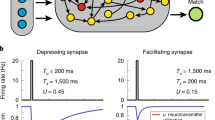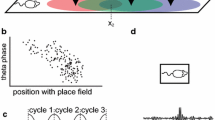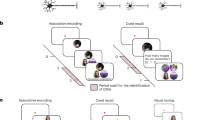Abstract
We present a neural network model of the storage of episode representations in working memory (WM). Our key idea is that episodes are encoded in WM as prepared sensorimotor routines, i.e. as prepared sequences of attentional and motor operations. Our network reproduces several experimental findings about the representation of prepared sequences in prefrontal cortex. Interpreted as a model of WM episode representations, it has useful applications in an account of long-term memory for episodes and in accounts of sentence processing.






Similar content being viewed by others
Notes
Manuscript in preparation, Knott and Takac: Locomotion actions as sequentially structured sensorimotor routines.
In fact, even when the network is used for perception of episodes, the selection mechanism has an impact on the agent’s behaviour. The expected episode is a sequence whose first two items are planned attentional actions: during perception, these actions will actually be executed by the agent, with results that depend on the world as well as on the agent’s expectations and which might well result in revisions to the selected episode. The model thus allows for active perceptual operations during the process of selecting an episode, creating the structural coupling between its representational system and the environment that is characteristic of embodied systems (see, for example, [32]).
The most obvious kind of ‘attentional actions’ are overt movements, such as saccades. But attentional actions also involve cognitive operations, in particular top−down activation of semantic representations. These top−down activation operations can encode either the expected result of a forthcoming object classification process [34] or the category of properties of a desired search target [35, 36]. Our attentional actions represent objects in the sense that they represent expected or sought-for object categories.
Since WM representations are normally understood to be ‘maintained in the face of incoming perceptual stimuli’, we have to assume a special operation to remove the current episode representation from the dynamic episodic buffer before the next episode begins—an operation that probably involves an element of self-inhibition (see, for example, Mayr and Keele [39]). In previous work [19], we have considered the nature of this operation, but in the present study, we just use the end-of-episode signal to stand in for this operation.
If the predicted episode ranked among multiple episodes predicted by the VLMM with equal frequency, e.g. occupying 2nd–4th position, its rank would be the upper bound, i.e. 2.
Candidates were determined by top−down reconstruction, i.e. replayed as a temporal sequence in the aggregate SM signal layer.
The distributed model performed better by 3.7 % in total grammaticality, 0.2 % in compatibility, 0.8 % in matches, 0.09 in rank, and 5.1 % in rank base [37].
References
Baddeley A, Hitch G. Working memory. In: Bower G, editor. The psychology of learning and motivation: advances in research and theory (Vol. 8). New York: Academic Press; 1974. p. 47–90.
Baddeley A. The episodic buffer: a new component of working memory? TICS. 2000;4(11):417–23.
Tulving E, Markowitsch H. Episodic and declarative memory: role of the hippocampus. Hippocampus. 1998;8:198–204.
Abraham W, Logan B, Greenwood J, Dragunow M. Induction and experience-dependent consolidation of stable long-term potentiation lasting months in the hippocampus. J Neurosci. 2002;22:9626–34.
Levelt W. Speaking: from intention to articulation. Cambridge: MIT Press; 1989.
Haarmann H, Cameron K, Ruchkin D. Short-term semantic retention during on-line sentence comprehension. Brain potential evidence from filler-gap constructions. Cognit Brain Res. 2003;15:178–90.
Mayberry M, Miikkulainen R. Incremental nonmonotonic sentence interpretation through semantic self-organization. The University of Texas at Austin: Department of Computer Sciences; 2008; AI08–12.
Ballard D, Hayhoe M, Pook P, Rao R. Deictic codes for the embodiment of cognition. Behav Brain Sci. 1997;20(4):723–67.
Knott A. Sensorimotor cognition and natural language syntax. Cambridge: MIT Press; 2012.
Knott A. Syntactic structures as descriptions of sensorimotor processes. Biolinguistics. 2014;8:1–52.
Wallenstein G, Eichenbaum H, Hasselmo M. The hippocampus as an associator of discontiguous events. Trends Neurosci. 1998;21:317–23.
Lee A, Wilson M. Memory of sequential experience in the hippocampus during slow wave sleep. Neuron. 2002;36:1183–94.
Cutsuridis V, Hasselmo M. Spatial memory sequence encoding and replay during modeled theta and ripple oscillations. Cognit Comput. 2011;3:554–74.
Haggard P. Human volition: towards a neuroscience of will. Nat Rev Neurosci. 2008;9:934–46.
Tessitore G, Prevete R, Catanzariti E, Tamburrini G. From motor to sensory processing in mirror neuron computational modelling. Biol Cybern. 2010;103:471–85.
Chambon V, Wenke D, Fleming S, Prinz W, Haggard P. An online neural substrate for sense of agency. Cereb Cortex. 2012;23:1031–7.
Tipper S, Lortie C, Baylis G. Selective reaching: evidence for action-centered attention. J Exp Psychol Hum Percept Perform. 1992;18:891–905.
Johansson R, Westling G, Backstrom A, Flanagan J. Eye-hand coordination in object manipulation. J Neurosci. 2001;21(17):6917–32.
Caza G, Knott A. Pragmatic bootstrapping: a neural network model of vocabulary acquisition. Lang Learn Dev. 2012;8:1–23.
Knott A. How infants learn word meanings and propositional attitudes: a neural network model. In: Hung TW, editor. Lang action. Berlin: Springer; 2014. p. 107–24.
Lee-Hand J, Knott A. A model of causative actions: from motor learning to syntactic structure. In: Proceedings of the 35th annual meeting of the cognitive science society. Berlin; 2013; p. 2849–2854.
Curtis C, D’Esposito M. Persistent activity in the prefrontal cortex during working memory. Trends Cognit Sci. 2003;7(9):415–23.
Barsalou L. Grounded cognition. Ann Rev Psychol. 2008;59:617–45.
Glenberg A, Gallese V. Action-based language: a theory of language acquisition, comprehension, and production. Cortex. 2012;48:905–22.
Tulving E. Elements of episodic memory. New York: Oxford University Press; 1983.
Barone P, Joseph JP. Prefrontal cortex and spatial sequencing in macaque monkey. Exp Brain Res. 1989;78:447–64.
Averbeck B, Chafee M, Crowe D, Georgopoulos A. Parallel processing of serial movements in prefrontal cortex. PNAS. 2002;99(20):13172–7.
Rhodes B, Bullock D, Verwey W, Averbeck B, Page M. Learning and production of movement sequences: behavioral, neurophysiological, and modeling perspectives. Hum Mov Sci. 2004;23:699–746.
Averbeck B, Sohn J, Lee D. Activity in prefrontal cortex during dynamic selection of action sequences. Nat Neurosci. 2006;9(2):276–82.
Shallice T, Burgess P. Deficits in strategy application following frontal lobe damage in man. Brain. 1991;114:727–41.
Kaller C, Heinze K, Frenkel A, Läppchen C, Unterrainer J, Weiller C, et al. Differential impact of continuous theta-burst stimulation over left and right DLPFC on planning. Hum Brain Mapp. 2013;34:36–51.
Ziemke T. What’s that thing called embodiment? In: Alterman R, Kirsh D, editors. Proceedings of the 25th Annual Conference of the Cognitive Science Society. Mahwah, NJ: Lawrence Erlbaum; 2003. p. 1134–9.
Kohonen T. Self-organized formation of topologically correct feature maps. Biol Cybern. 1982;43:59–69.
Kahneman D, Treisman A, Gibbs B. The reviewing of object files: object-specific integration of information. Cognit Psychol. 1992;24:175–219.
Hasegawa R, Matsumoto M, Mikami A. Search target selection in monkey prefrontal cortex. J Neurophysiol. 2000;84:1692–6.
Fix J, Rougier N, Alexandre F. A dynamic neural field approach to the covert and overt deployment of spatial attention. Cognit Comput. 2011;3:279–93.
Takac M, Knott A. A revised neural network model of episode representations in working memory. Dept of Computer Science, University of Otago; 2014; OUCS-2014-03.
Strickert M, Hammer B. Merge SOM for temporal data. Neurocomputing. 2005;64:39–71.
Mayr U, Keele S. Changing internal constraints on action: the role of backward inhibition. J Exp Psychol Gen. 2000;129(1):4–26.
Vickers D, Lee MD. Dynamic models of simple judgments: II. Properties of a self-organizing PAGAN (parallel, adaptive, generalized accumulator network) model for multi-choice tasks. Nonlinear Dyn Psychol Life Scie. 2000;4(1):1–31.
James DL, Miikkulainen R. SARDNET: a self-organizing feature map for sequences. In: Tesauro G, Touretzky DS, Leen TK, editors. Advances in neural information processing systems 7. Cambridge: MIT Press; 1995. p. 577–84.
Miikkulainen R. Subsymbolic case-role analysis of sentences with embedded clauses. Cognit Sci. 1996;20:47–73.
Chang F. Symbolically speaking: a connectionist model of sentence production. Cognit Sci. 2002;26:609–51.
Rohde D. A connectionist model of sentence comprehension and production. School of Computer Science. Carnegie Mellon University; 2002.
Takac M, Benuskova L, Knott A. Mapping sensorimotor sequences to word sequences: a connectionist model of language acquisition and sentence generation. Cognition. 2012;125:288–308.
Collins M. A new statistical parser based on bigram lexical dependencies. In: Proceedings of the 34th meeting of the ACL. Santa Cruz; 1996; p. 184–191.
Dispaldro M, Leonard L, Corradi N, Ruffino M, Bronte T, Facoetti A. Visual attentional engagement deficits in children with specific language impairment and their role in real-time language processing. Cortex. 2013;49:2126–39.
Balconi M. Dorsolateral prefrontal cortex, working memory and episodic memory processes: insight through transcranial magnetic stimulation techniques. Neurosci Bull. 2013;29(3):381–9.
Burgess N, Hitch G. Memory for serial order: a network model of the phonological loop and its timing. Psychol Rev. 1999;106:551–81.
Burgess N, Hitch G. A revised model of short-term memory and long-term learning of verbal sequences. J Mem Lang. 2006;55(4):627–52.
Brown GDA, Hulme C, Preece T. Oscillator-based memory for serial order. Psychol Rev. 2000;107:127–81.
Howard M, Kahana M. A distributed representation of temporal context. J Math Psychol. 2002;46:269–99.
Page M, Norris D. A model linking immediate serial recall, the Hebb repetition effect and the learning of phonological word forms. Philos Trans R Soc B. 2009;364:3737–53.
Botvinick MM, Plaut DC. Short-term memory for serial order: a recurrent neural network model. Psychol Rev. 2006;113(2):201–33.
Dominey P, Arbib M, Joseph JP. A model of corticostriatal plasticity for learning associations and sequences. J Cognit Neurosci. 1995;7(3):311–36.
Dominey P, Hoen M, Inui T. A neurolinguistic model of grammatical construction processing. J Cognit Neurosci. 2006;18(12):2088–107.
Shastri L. Episodic memory trace formation in the hippocampal system: a model of cortico-hippocampal interaction. Berkeley: International Computer Science Institute (ICSI), UC Berkeley; 2001; TR-01-004.
van der Velde F, de Kamps M. Neural blackboard architectures of combinatorial structures in cognition. Behav Brain Sci. 2006;29:37–108.
Stewart T, Eliasmith C. Compositionality and biologically plausible models. In: Werning M, Hinzen W, editors. The Oxford handbook of compositionality. New York: Oxford University Press; 2012.
Dennis S. A memory-based theory of verbal cognition. Cognit Sci. 2005;29(2):145–93.
Reynolds J, Zacks J, Braver T. A computational model of event segmentation from perceptual prediction. Cognit Sci. 2007;31:613–43.
Acknowledgments
This research was supported by NZ Marsden Fund, and partially supported by grants VEGA 1/0898/14 and KEGA 076UK-4/2013 for Martin Takac. We are grateful to Lubica Benuskova and Igor Farkas for helpful discussions.
Author information
Authors and Affiliations
Corresponding author
Rights and permissions
About this article
Cite this article
Takac, M., Knott, A. A Neural Network Model of Episode Representations in Working Memory. Cogn Comput 7, 509–525 (2015). https://doi.org/10.1007/s12559-015-9330-3
Received:
Accepted:
Published:
Issue Date:
DOI: https://doi.org/10.1007/s12559-015-9330-3




